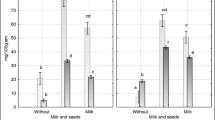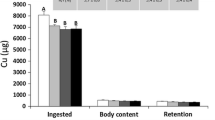Abstract
The breakfast cereals are among the main sources of calcium, but the other dietary components may influence on availability of this element. The purpose of this study is to establish the availability of calcium in the breakfast cereals marketed in Spain and compare the positive and negative effects of various components of these foods. The availability of calcium (expressed as % dialysed Cr) from breakfast cereals (n = 93) is evaluated by an in vitro method that involves a simulated human gastrointestinal digestion followed by measurement of dialysability of Ca by AAS. Dialysable Ca ranged from 0.59 to 26.21 %, with a mean value of 7.5 ± 5.88 %. Different correlations are studied between calcium and other breakfast cereal components (lipids, carbohydrates, minerals, vitamins…). Calcium dialysable is correlated significantly with total lipid and quality lipid, iron or starch (p = 0.0079, 0.0371, 0.0356 and 0.0115, respectively). This parameter is affected negatively by the fibre (r = −0.2947) and total phosphorus (r = −0.2426).




Similar content being viewed by others
References
Mahan LK, Escott-Stump S (1993) Nutrición and Dietoterapia de Krause. McGraw Hill, Mexico
Van Beresteijn (1993) In: Schlemmer U (ed) Bioavailability’93. Bundesforschungsanstalt für Ernährung, Karlsruhe
Zemel MB (2001) Calcium modulation of hypertension and obesity: mechanisms and implications. J Am Coll Nutr 20:428S–435S
Miller DD (1989) Calcium in the diet: food source, recommended intakes and nutritional availability. Adv Food Nutr Res 33:103–156
Wark JD (2003) Calcium supplementation: the bare bones. Aust Preser 26:126–127
Tobelmann R (2001) Implementing Calcium fortification: an industry case study. J Food Compos Anal 14:241–244
Camara F, Amaro MA (2002) Influence of dietary factors on Ca availability: a brief review. Biol Trace Elem Res 89(1):43–54
Larsson M, Sandberg AS (1992) Phytate reductions in oats during malting. J Food Sci. doi:10.1111/j1365-2621.1992.tb14340x
Fretzdorff B (1993) Phytic acid reduction in cereal processing. In: Schlemmer U (ed) Bioavailability’93. Bundesforschungsanstalt für Ernährung, Karlsruhe
Tala de Souza EM, de Sousa LM, Fernandes Arruda S, de Almeida Siqueira EM (2002) Protein improves the availability of calcium and phosphorus from an alternative dietary supplement in rats. Nutr Res 22:945–955
Perales S, Barberá R, Lagarda MJ, Farré R (2005) Availability of Calcium from milk-based formulas and fruit juices containing milk and cereals estimated by in Vitro methods (solubility, dialyzability, and uptake and transport by caco-2 cells). J Agric Food Chem 53(9):3721–3726
Miller DD, Schricker BR, Rasmussn RR, Van Campen D (1981) An in vitro method for estimation of iron availability from meals. Am J Clin Nutr 34:2248–2256
Frontela C, Haro JF, Ros G, Martínez C (2008) Effect of dephytinization and follow-on formula addition on in Vitro Iron, Calcium and Zinc availability from infant cereals. J Agric Food Chem 56:3805–3811
Roig MJ, Alegría A, Barberá R, Farré R, Lagarda MJ (1999) Calcium dialysability as an estimation of availability in human milk, cow milk and infant formulas. Food Chem 64:403–409
Kamchan A, Puwastien P, Sirichakwasls PP, Kongkachuichoi R (2004) In vitro calcium availability of vegetables, legumes and seeds. J Food Compos Anal 17:311–320
Mateos CJ, Aguilar MV, Martínez Para MC (2005) Chromium content in breakfast cereals depending on cereal grains used in their manufacture. Eur Food Res Technol 220(1):42–46
Mateos CJ, Aguilar MV, Martínez Para MC (2008) In Vitro chromium availability in breakfast cereals. Eur Food Res Technol 226(3):531–536
Instituto de Racionalización and Normalización del Trabajo. Una Norma Española UNE 64017
Moreiras O, Carbajal A, Cabrera L, Cuadrado C (2004) Ingestas Recomendadas de energía y nutrientes (Revisadas 2002). In: Tablas de composición de alimentos. Ed. Pirámide. Madrid
Lombardi-Boccia G, De Santis N, Di Lullo G, Carnovale E (1993) Processing and in vitro mineral dialysability of legumes. In: Schlemmer U (ed) Bioavailability’93. Bundesforschungsanstalt für Ernährung, Karlsruhe
Sergiel I, Pohl P (2010) Determination of the total content of calcium and magnesium and their availability in ripened beed honeys. J Agric Food Chem 58:7497–7501
Ranhotra GS, Geiroth JA, Leinen SD, Rao A (1997) Availability of calcium in a high calcium whey fraction. Nutr Res 17(11/12):1663–1670
Hartmann R, Meisel H (2002) Cytochemical assessment of phosphopeptides derived from casein as potential ingredients for functional food. Nahrung 46:427–431
Jovani M, Barberá R, Farré R (2001) Review: effect of some components of milk- and soy-based infant formulas on mineral availability. Food Sci Technol Int 7:191–198
Ferraretto A, Signorile A, Gravaghi C, Fiorilli A, Tettamanti G (2001) Casein phosphopeptides influence calcium uptake by cultured human intestinal HT 29 tumor cells. J Nutr 131:1655–1661
Ferraretto A, Gravaghi C, Fiorilli A, Tettamanti G (2003) Casein derived bioactive phosphopeptides: role of phosphorilation and primary structure in promoting calcium uptake by HT-29 tumor cells. FEBS Lett 551:92–98
Hansen M, Sandstrom B, Lonnerdal B (1996) The effect of casein phosphopeeptides on zinc and calcium absorption from high phytate infant diet assessed in rat pups and Caco-2 cells. Pediatr Res 40:547–552
Ekmekcioglu C (2002) A physiological approach for preparing and conducting intestinal availability studies using experimental systems. Food Chem 76:225–230
Borgheri SM (1982) Effects of wheat bran on the metabolism of calcium-45 and zinc-65 in rats. J Nutr 112:2047
Bosscher D, Van Caillie-Bertrand M, Van Cauwenbergh R, Deelstra H (2003) Availabilities of Ca, Fe and Zn from dairy infant formulas is affected by soluble dietary fibers and modified starch fractions. Nutrition 19:641–645
Fernández MM, Aranda P, López-Juado M, Urbano G, Frías J, Sotomayor C, Vidal-Valverde C (1993) Availability of phosphorus in raw and processed fava. In: Schlemmer U (ed) Bioavailability’93. Bundesforschungsanstalt für Ernährung, Karlsruhe
Author information
Authors and Affiliations
Corresponding author
Rights and permissions
About this article
Cite this article
Aguilar, M.V., Mateos, C., Meseguer, I. et al. Calcium availability in breakfast cereals: effect of other food components. Eur Food Res Technol 235, 489–495 (2012). https://doi.org/10.1007/s00217-012-1773-0
Received:
Revised:
Accepted:
Published:
Issue Date:
DOI: https://doi.org/10.1007/s00217-012-1773-0




